London Journal
By Christine Cotton
The Spring Break Experience

Darling Christine,
Remember the year you toured Eastern Europe during spring break instead of relaxing on a beautiful beach in Mexico? Remember running all over different cities, instead of sitting at the poolside bar drinking Miami Vices? Remember struggling to order food in Hungarian instead of leisurely choosing a selection of food from a resort’s buffet line? Remember how it was completely worth all of the stress and the pain because in the end it was a wonderful experience and you saw so many beautiful things you might never see again?
It’s March 2008 and I am two months into my study abroad program in London, England. We had a week off this month for spring break, and my friends Alysha, Kristan, Fernando, and I decided we would travel together to Budapest, Vienna, and Prague. We arranged to fly into Budapest on Friday, March 7th, and then fly back to London from Prague on Saturday, March 15th. As for getting from Budapest to Vienna, and then Vienna to Prague, we planned to buy our train tickets while traveling.
I admit I had been nervous about visiting these three particular countries because no one in our group of four knew any Hungarian, German, or Czech. I could not remember the last time I was in this situation! Last fall I went to Paris but I visited my friend Kara while I was there, and she was fluent in French so she assisted me whenever needed. I had also visited Italy and Portugal, but because I can speak Spanish I found it relatively easy to understand Italian and Portuguese, plus many people that I met while traveling spoke English. Fortunately for us, we found a similar situation when we arrived in Budapest – it seemed as though everyone spoke at least some English. Thank God! While our taxi driver did not know much English, he did give us our only lesson in Hungarian. When Fernando entered the cab he showed the driver the address and said, questioning his own pronunciation, “We need to go to Sip Utca?”
“Utca?” the cabbie replied. “Utca means STREET,” he told us in his harsh accent. He said no more to us after that but we had learned the first and only word we would ever learn in Hungarian.
Budapest was amazing, although it was obvious that the country was still recovering from the Soviet Occupation (which had only fallen in 1989). There were a great number of homeless people; one time we walked through a metro underpass and underneath were four mattresses where homeless people were sleeping; all their few belongings were strewn about beside them. It was sad. I also noticed an overwhelming amount of prostitutes after dark.
But the city itself was beautiful albeit its social problems. It seemed as though there was something to see around every corner. Our hostel was on the Pest side… as you know Budapest is actually two cities: Buda and Pest, separated by the Danube River. On our first evening in Hungary we took a walk down by the Danube River on the Pest side, but when we looked across the river we could see the beautiful Buda side and its Castle district all lit up.

After our walk we ate at an amazing Hungarian restaurant called Fatâl, which was recommended to us by an employee at our hostel. We had a hearty meal that consisted of lots of meat, eggs, and potatoes. Kristan had beef goulash and Alysha even ordered schnitzel.

During the rest of our days in Budapest we visited a few castles, saw the Opera House and Hero Square, went to the Terror House Museum (which taught us about Nazism and Soviet Occupation in Hungary), and went to Hungary’s biggest market. I think the most beautiful thing I saw was the fountain of Neptune we just happened to stumble across while exploring. Neptune adorned the top of the fountain and its base was decorated by three women, perhaps goddesses or muses.

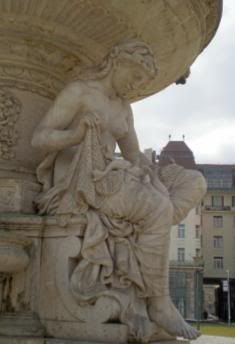
We spent three days in Budapest, and on Monday morning of spring break we went to the train station and caught a train to Vienna. Upon arrival we found that our hostel was conveniently close to the train station – about a ten minute walk. So we bought our train tickets for Wednesday to Prague, and then moved onward to find our hostel.
Our hostel, the Wombat, was really cool! It had a bar downstairs that was open each night until 2 AM and the whole place was painted in funky, bright colors. There was even a giant wombat painted on the wall in the bar!
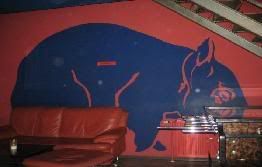
After we checked in we jumped on the metro, located by the train station, and took the orange line to Stephenplatz where the Stephenplatz Cathedral is located. Vienna’s metro has much fewer lines than London’s Underground so it was easy and efficient to use while we were staying there. Once you came out of the underground at Stephenplatz, you could see the giant cathedral standing directly in front of you. It was beautiful, although unfortunately undergoing some construction. What I liked most about the cathedral, and what my friends liked least about it, was its mosaic roof.
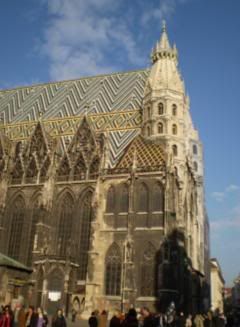
I’ve never seen a cathedral with a mosaic before, and I thought it was both beautiful and unique! We also saw the Hofburg Palace, Belvedere Palace, the famous Opera House, and a number of fountains and monuments. I really liked a the Plague Monument, which had been made in memory of the lives lost during the plague. Here an angel is throwing a deformed, hideous woman down into a well. The vile woman is actually the plague and she is being destroyed.
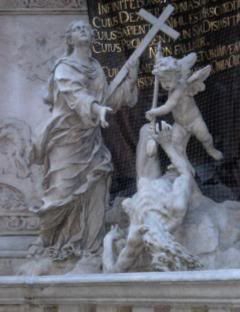
Since our stay in Vienna was nice but not as exciting as Budapest, we were glad that we had decided to spend only two nights in Vienna as opposed to the three nights we had spent in Budapest and the three nights we would spend in Prague. So on Wednesday morning we went back to the Westbanhof train station to catch our train to Prague but happened to notice that the train we were due to take was not on the schedule board. We sat in curiosity for a few moments before I took a look at my ticket and…
It said Sudbanhof. The train was leaving from a different station. Foolishly, we had never looked at our tickets because we had bought the tickets from the Westbanhof station and therefore assumed the train would depart from Westbanhof as well. Wrong. We ran out of the train station and hailed a taxi, we had about a half hour to make it to the Sudbanhof train station before we missed our train. Lucky for us it took only 20 minutes or so to get there and we got up to platform four about five minutes before our train came! So there was no idling or waiting around, and we were all very thankful we had made it! We climbed on board and began our journey into Prague.
We arrived in Prague around 2:00 in the afternoon, hailed a cab, and were driven to our hostel. Our hostel turned out to be amazing! It was nicer than some hotels I’ve stayed in! The receptionist showed us our room before asking us if we would take it or not – the “room” was actually two rooms, with its own kitchen, dining area, and bathroom! Of course we took it! Not only that, but it would only end up costing us around $20 a night to stay there!
The hostel was only the beginning. Prague was adorable! In Old Town Square there is a market everyday, with shops and food stalls! It was as if there was a carnival going on nearly every hour of the day. We bought an endless amount of souvenirs as well as snacks. I became particularly found of the mulled wine, which is just hot red wine with cinnamon and a few other spices added. Here is a picture of the open air market we visited each day in Prague:
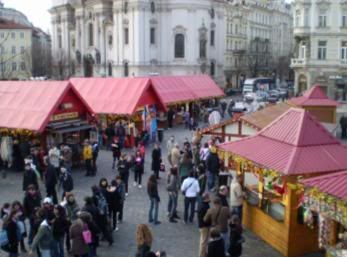
Not only did we see the market, but we visited Prague Castle, the Jewish Quarter, and a number of very cool museums (including the Toy Museum, the Medieval Torture Museum, and the Sex Machine Museum). The Toy Museum had an entire floor devoted to Barbies… I was fascinated. I have nearly sixty pictures of different Barbies but will not use this as an opportunity to burden you with them now. Knowing myself, I have made prints of everything and have neatly stored them away in a number of photo albums, so if you (Christine of the future) feel the desire to reminisce, take out the old albums and spend some time with them, and remember the wonderful experiences you’ve had traveling all over Europe!
- With love,
- from Yourself
Entry V: An Interview with Churchill, the Man who Never, Never, Never Gave Up
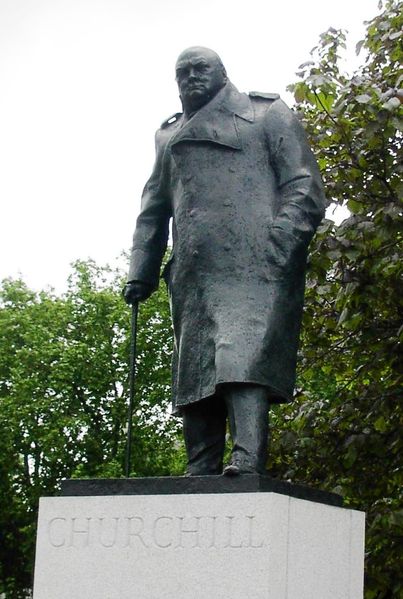
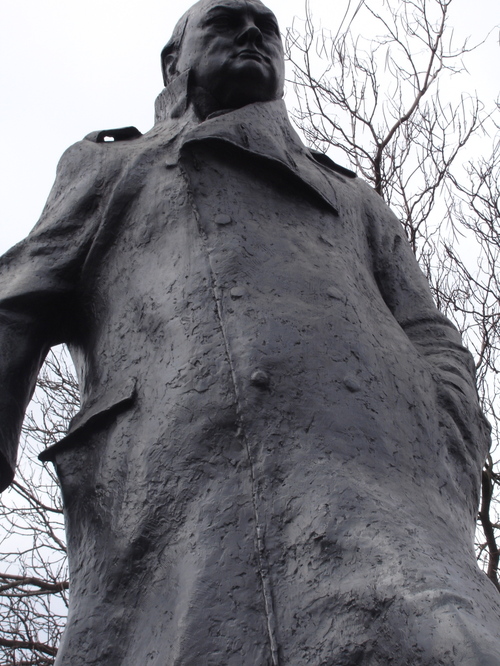 <
<
The Churchill monument in Parliament Square
Christine Cotton: Good afternoon Sir, how are you today?
Sir Winston Churchill: Fine, and yourself?
CC: Doing well, thank you. I have a few questions for you in relation to your life, work, and influence on the United Kingdom.
WC: I will try my best to answer them for you.
CC: Thank you Sir. I understand you had trouble in school as a youth?
WC: Initially, I found myself uninterested in my studies, although excelled once I entered the Harrow School in 1888 and began my military education. I think I found success there because it was something I was truly interested in.
CC: Was it hard being away from home for the first time?
WC: I was never close with my father, but I always corresponded with my mother through letters. I honestly missed my nanny, Mrs. Everest the most. I spent much of my childhood being looked after by her; she was very dear to me.
CC: What did you do after graduation?
WC: I entered the army. I was a made an officer and later became a war correspondent. I commanded the Sixth Battalion of the Royal Scots Fusiliers.
CC: Amazing accomplishments, especially because your stint in the military was so brief. Do you think your military career helped you as a politician?
WC: Absolutely. If I had not seen the horrors of war firsthand, it would have been much harder to encourage the Allied troops during WWII. I also believe that my military experience was crucially essential in leading the country during war.
CC: Definitely. I know you have some interesting stories about your military career. Can you share one with us?
WC: One story comes to mind that you may find interesting. When I was working as a war correspondent during the Second Boer War in South Africa, I was captured as a Prisoner of War. I actually managed to escape from prison, and I traveled nearly 300 miles Delagoa Bay. Once I was safe, I rejoined the army and continued my work as a war correspondent. But I will never forget the long journey I made after escaping, and I will never forget the fear I had of being recaptured.
CC: How brave! Not many people have stories like that!
WC: You flatter me too much.
CC: Now let’s talk about politics. You stood for Parliament in 1899 but lost. The following year, in 1900, you ran for Parliament again and won a seat. After that, your political career took off. What are your fondest memories from the beginning of your political career?
WC: In 1910 I became Home Secretary. I had the opportunity to make social reforms in my country. I made many reforms within British prisons; I had my own experience in jail [as a POW], so I wanted to make sure conditions in British prisons were just.
CC: And in 1911 you became the First Lord of the Admiralty and helped to modernize the navy! In 1915 you joined the War Council. And all of these achievements are just the tip of the iceberg!
WC: All of these things are true, but there were difficult times in my political career as well.
CC: Now the real question is, how did you end up being one of Britain’s greatest Prime Ministers?
WC:Well, there is no short answer for this but I will try to be concise. Obviously, I did not wake up one morning and decide I wanted to run a country. In 1940 I was reappointed First Lord of the Admiralty. Neville Chamberlain was Prime Minister at the time. After the outbreak of WWII, it became clear that Chamberlain was not the man to lead our nation in this time of trouble. Parliament also agreed. The long and the short of it is that Chamberlain ended up resigning from his post in May 1940. And then King George VI appointed me as the new Prime Minister.
CC: That must have been an exciting day.
WC: Of course it was, but I knew the road that lay ahead of me would not be easy. Especially with Hitler's rising power.
CC: But I don't think that Britain could have asked for a better leader in WWII. You were brave enough to hide underground in central London during the Blitz with your cabinet. And you were confident enough to encourage your people and soldiers by continuously making public broadcasts, talking to the people directly, instead of keeping them in the dark. This is no small feat and this is one of the reasons you are so famous today.
WC: How strange it is, to be so well known even now.
CC: There's a Winston Churchill Museum now, you know. Visitors are allowed to tour the Cabinet War Rooms where you and the other members of Parliament hid during the WWII bombings, and then the museum follows up by teaching visitors about your work and your life. And they make lots of Churchill souvenirs.
WC: That seems almost silly.
CC: It seems reasonable enough, that you would still have a fan base 43 years after your death... you are, after all, a major figure it British history.
WC: Thank you.
CC: You’re welcome. And thank you for your interview. It was a pleasure to meet with you.
WC: It was a pleasure to meet with you as well.
CC: Have a good day Sir, and thank you for your contributions to world history. Sir Winston Churchill - truly a remarkable man.
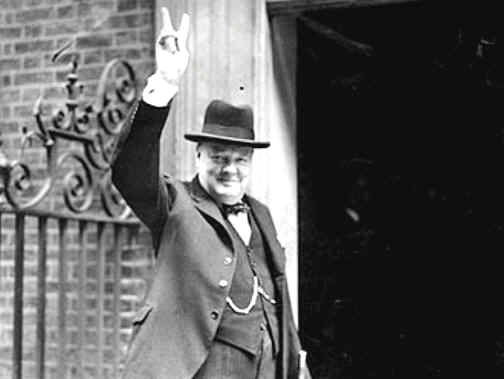
Churchill giving the victory sign
References
"Winston Churchill." Spartacus Educational. http://www.spartacus.schoolnet.co.uk/PRchurchill.htm.
"Biography." The Nobel Foundation, 1953. http://nobelprize.org/nobel_prizes/literature/laureates/1953/churchill-bio.html.
Beloved London

I have lived away from home many times. I spent my first two years at UCONN living on campus. Last summer, I lived with a host family in Guasmo Sur, one of the poorest communities in Ecuador. We fit nine people into our 3-bedroom “house”, which was made of concrete blocks. And this past fall I lived in Spain.
But nothing has been as hard as living here in London. Sometimes personalities just clash and people do not get along. Exhibit A: Flat 10. That is why my favorite place in London is not actually a place – it is many places.
I love strolling around the streets of my neighborhood. Sometimes when I have just had enough, I get up and go out and I wander around. I particularly enjoy the walk down to the Brunswick Center: right out the door, left on to Clerkenwell, right onto Grey’s Inn Road, left onto Guilford Street. I have found so many interesting little places along the way. Grey’s Inn Road is full of adorable little cafes, my favorite being Andrew’s where I have frequented for breakfast many times. If you stay straight on Clerkenwell you will end up on Holborn, which is home to the Holborn Library, a nice refuge place at times. There’s a park on Guilford Street called Coram Fields which even has a little petting zoo. There are two black sheep which Alysha and I have been known to feed on multiple occasions. Just past the petting zoo and children’s park is another park in front of the Brunswick Shopping Center. On a beautiful day you will see many people taking a short cut through this park just to make their walk a little more enjoyable.
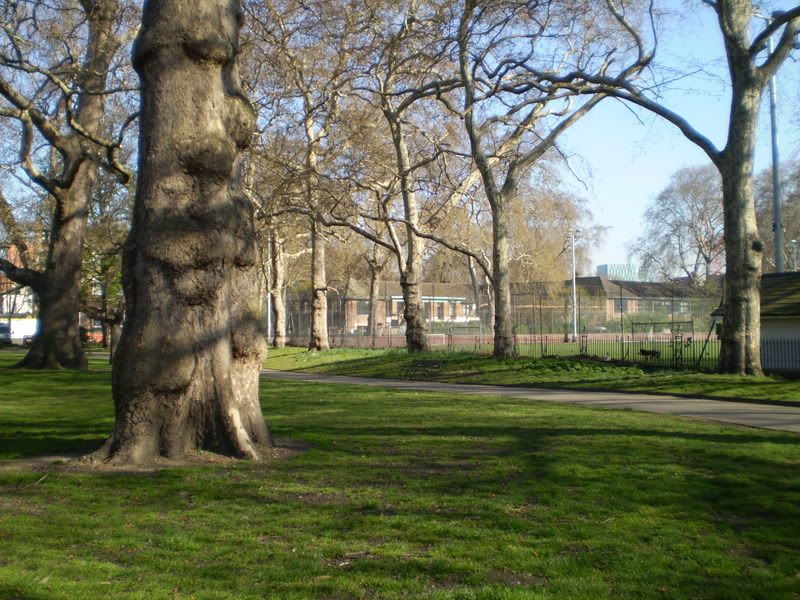
Instead of trying to describe the park, I have included multiple photos of the area. This is the park behind the Brunswick Center. London has a surprisingly amount of parks for being such an overcrowded city. Sometimes for me, these patches of green, however small they are, keep me sane in the big and polluted city.
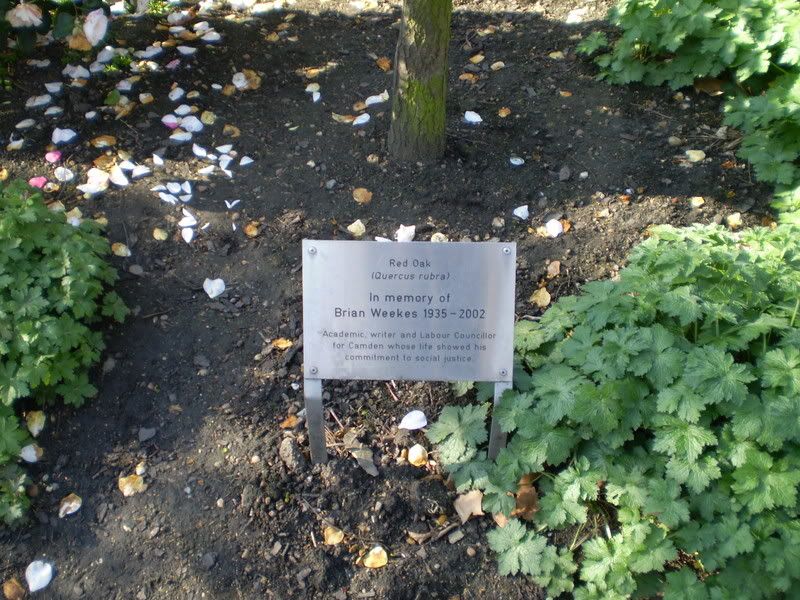
This plaque caught my eye the other day. It reads: “Brian Weekes / 1935-2002 / Academic, writer, and Labour Councillor for Camden whose life showed his commitment to social justice.” The plaque touched me and I felt admiration for Brian Weekes, whose contributions to society meant enough to some that an oak tree was planted in his honor in this city park. I hope someday I can make a significant and meaningful contribution to the world.
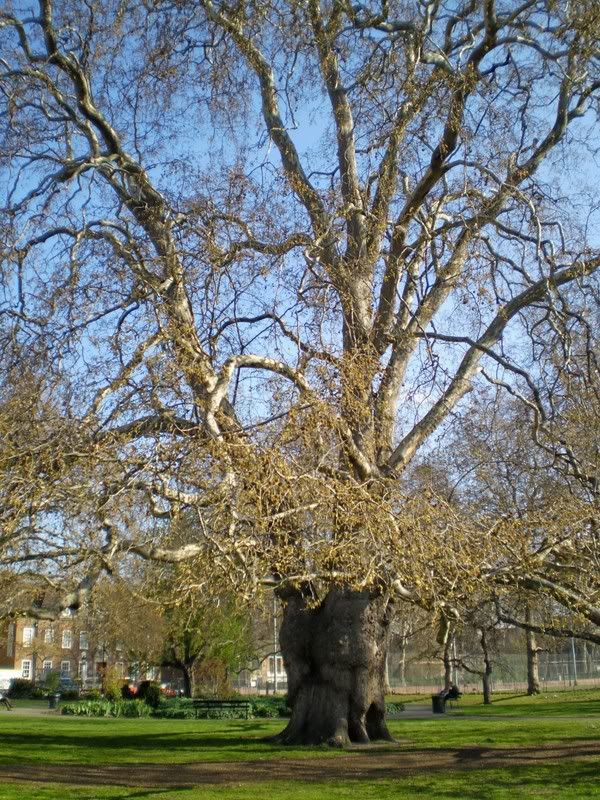
Today I saw a man holding his toddler up on the lowest branch of this tree and swinging it gently; the child was laughing and obviously pleased. His father was smiling because he had made his son smile, and the feeling was clearly contagious.
There you have it: my favorite place in London, if you can call it a place. This week I have been making this walk every morning, and expanding my exploration further and further. There is so much of London to see that it would be impossible to see it all, but at leat I have found a cosy little niche for myself that is my home away from home.










 <
<

